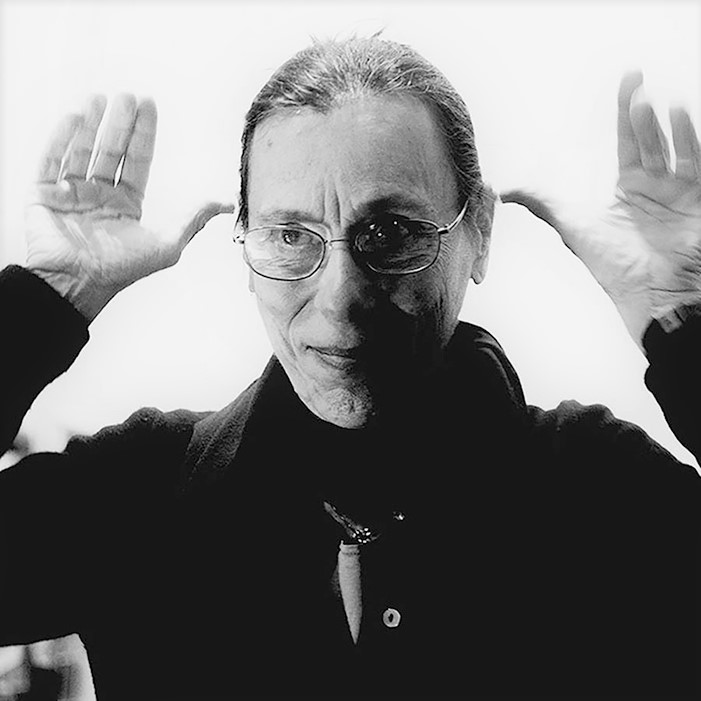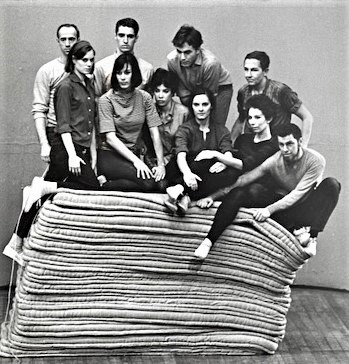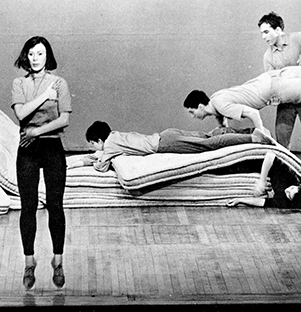Join the ICONS
Dance ICONS is a global network for choreographers of all levels of experience, nationalities, and genres. We offer a cloud-based platform for knowledge exchange, collaboration, inspiration, and debate. Dance ICONS is based in Washington, D.C., and serves choreographers the world over.
Subscribe today to receive our news and updates. Become a member of your global artistic community -- join the ICONS!
YVONNE RAINER: REIMAGINING DANCE WITH PARTS UNKNOWN

Acknowledged widely as the icon of American postmodern dance, Yvonne Rainer has for decades been a driving force in reshaping the art form by introducing radical ideas and innovative concepts. Vladimir Angelov, Artistic and Executive Director of Dance ICONS, Inc. recently spoke with her about her past work, current artistic interests, and the latest developments in her creative space.
ICONS: You are currently working with Emily Coates of Yale University on a new book about your mattress piece. Could you please tell us about this exciting project?
Yvonne Rainer: The book is tentatively titled Yvonne Rainer’s Parts of Some Sextets: Reimagining a Dance. The book will contain essays by David Thomson, SoYoung Yoon, Lynne Tillman, Emily Coates, and myself and will deal with the origin and development of that particular dance.
 ICONS: Are you working on a new choreographic project at the moment, and what is it about?
ICONS: Are you working on a new choreographic project at the moment, and what is it about?
YR: The tentative title for an upcoming new project is Hellzapoppin’ Indexical. Among the movement sources will be the 1941 Hollywood film Hellzapoppin’ and an early favorite of mine, Jean Vigo’s 1933 film Zero de Conduit. I myself will function as a kind of bumbling MC trying, sometimes futilely, to extricate herself from charges of racism and copyright infractions.
ICONS: Which directions within your creative space are you most excited to explore?
YR: A frequent ploy from very early on in my career has been the interplay of movement and speech. In recent and current work, I sometimes ask a performer to stop what he/she is doing and read from a text. The physical performance continues to involve trained and athletic movement derived from a number of sources, including sports, films, and my own historical grab bag.
ICONS: How would you describe in your own words your involvement in Grand Union, and do you still keep in touch, personally and creatively, with your collaborators?
YR: My involvement with the Grand Union was short-lived, from 1970 to around 1972 when I became more invested in filmmaking, while the other members went on for another four years. I keep in touch with some of them, like Steve Paxton, David Gordon, and Barbara Dilley, and try to keep up with their work.
ICONS: What led you to the establishment of Judson Dance Theater?
YR: The Judson Dance Theater evolved from a workshop conducted by Robert Dunn in the Merce Cunningham Studio between 1960 and ‘62. A few of us auditioned the work we had made there for a dance concert at the YMHA [Young Men's Hebrew Association] in New York City and were all turned down. The result was that we approached Al Carmines, a reverend at Judson Church, and he welcomed us in, not only for performances but weekly workshops in the Judson gym. The official programs included all work that was shown in the gym and was organized by three-person committees selected from the attendees at the workshops.

ICONS: How has your work evolved over the past few decades?
YR: In all kinds of ways, from early solos constructed through chance procedures, to full-blown group pieces involving combinations of pedestrian and technique-based movement, props, projected slides and films, trained and untrained performers and visual artists, and “radical juxtaposition” (a Susan Sontag term) of speech or texts with choreographed configurations. The subject matter has ranged from abstract dance, rule games, unison, and chance-based moves, along with topical social and political material dealing with racial, environmental, and sexual issues.
ICONS: You have decided to transition from dance and choreography to film and writing. What made you explore creatively in these other mediums?
YR: From very early in my career I had started to write as a way of clarifying for myself — and prospective spectators — my choreographic intentions. In retrospect, neither does a turn to filmmaking at a certain point seem surprising in that I had followed avant-garde and foreign films from an early age.
Compounding this history was what I saw as “the problem” of my aging body as a primary source for movement plus a series of illnesses that further dampened whatever choreographic ardor remained. Having been exposed to the so-called “New American Cinema” and especially to the films of Maya Deren, Hollis Frampton, and Michael Snow, I was ready to make the move from dance to film.
However, although the “dance bug” continued to infuse my movies in the form of “would-be” plots about — and fictional roles played by — actual dancers, lo and behold, when 25 years later Mikhail Baryshnikov invited me to make a dance for his company, I jumped at the chance. By that time, filmmaking, with its ballooning expenditures and exhausting complications heightened by my techno-stupidities around technicians and laboratories, had lost its allure. By 1999, I had come “home.”

ICONS: In the total body of works you have created, is there a particular piece that encapsulates your entire artistic philosophy? Which work is that, and how so?
YR: I can’t think of a singular work, but perhaps “The Mind Is a Muscle,” “Lives of Performers,” “Parts of Some Sextets,” and “MURDER and murder” might suffice, with the caveat that such “encapsulations” can only lead one astray. In fact, one of my favorite dances is “After Many a Summer Dies the Swan,” the one commissioned by Baryshnikov in 2000. But that is not to say that everything since has been all downhill!
ICONS: If you could travel back in time, is there anything you would have done differently as an artist? For example, you have been very sensitive about not popularizing your “No Manifesto.” Why?
YR: Because it belongs to a particular time and set of circumstances and has had little or no relevance to my life and art-making for the last 50 years. So, no “traveling” back and forth. Let’s move forward!

VIDEO SAMPLE:
Trio A (THE MIND IS A MUSCLE, Part I) (1978),
choreography and performance by Yvonne Rainer | FULL MOVIE
https://www.youtube.com/watch?v=2EXFjfStP7c
MORE ABOUT YVONNE RAINER:
Born on November 24, 1934, in San Francisco, California, American avant-garde choreographer and filmmaker Yvonne Rainer has defied conventional expectations by creating dance and film often featuring the mediums’ most fundamental elements. Rainer co-founded the Judson Dance Theater, a focal point for vanguard activity in the dance world throughout the 1960s, and she formed her own company for a brief time after the Judson performances ended. Rainer’s approach to dance is to treat the body as the source of an infinite variety of movements rather than as a purveyor of emotion or drama.
Rainer’s best-known dance, “Trio A,” (1966) a section of a larger work called The Mind Is a Muscle (1966–68), consisted of a simultaneous performance by three dancers that included a series of circular and spiral movements. The piece was widely adapted and interpreted by other choreographers. Rainer choreographed more than 40 concert works, including commissions by Mikhail Baryshnikov for his White Oak Dance Project.
Rainer’s early films do not follow narrative conventions but instead combine reality and fiction, sound and visuals, to address social and political issues. Her film works have received several awards, and in 1990 she was a recipient of a MacArthur Foundation “Genius” Award.
PHOTOGRAPHY CREDITS:
Potrait of Yvonne Rainer, photograohy © Daniel Assayag, 2014
Mattress Piece: Parts of Some Sextets, by Yvonne Rainer, photography © Peter Moore, 1965
Film Still: Murder and Murder, by Yvonne Rainer,1997
Dance Triptych: Trio A (THE MIND IS A MUSCLE, Part I), Judson Dance Theater photo archive, 1978
INTERVIEW TEAM:
Interviewer: Vladimir Angelov, Artistic and Executive Director of Dance ICONS, Inc.
Content Editor-in-Chief: Camilla Acquista
Research Associate: Charles Scheland
Dance ICONS, Inc., October 2021 © All rights reserved
![]()
